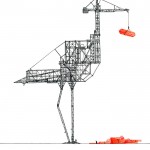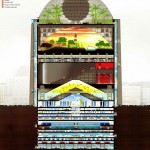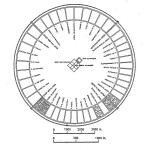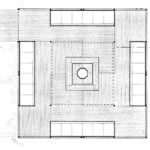In 1971, German graphic designer and photographer Gunter Rambow produced a series of posters tackling the failing realm of urban planning and building construction.
The work used documentary-style photographs and strong typography, in a way that reminds the work of contemporaneous artist Barbara Kruger, to caustically comment on the role of each agent involved in this realm.
The most striking issues and contradictions are explained in simple yet thorough way, from the explicitly concerned political perspective of a declared left-wing designer such as Rambow.
Note: we have made the translations from German to English, but, as non-mothertongue in neither languages, we can’t assure you of the correctness. Any help and revision, as well as further informations on the works and the circumstances in which they are born, are greatly appreciated.
From a recent interview:
Y S-S: What about apolitical design?
GR: Yes, that exists.
Y S-S: But any statement is political in some way.
GR: Design itself is not actively political but an expression of a political situation.

The Developer
The developer thinks only in large numbers, he builds series of housing units for hundreds of residents. Result: Uniform, replaceable housing estates from Flensburg to Berchtesgaden. Must it stay that way?

The Architect
The architect does not receive a clear, well thought set of tasks. Since there is rarely one personally responsible owner, the architect has to take over his role. He has to design for people without knowing them really. Numerous institutions join in the conversation. Indeed, he has to answer for the mistakes of the recent past and his responsibility is, however, out of proportion of his actual influence. Must it stay that way?

The Human Scientist
The Human Scientist, (for example, physician, psychologist, sociologist), is a voice in the desert. What he demands, e.g., for children and marginalized social groups, costs too much for one, is unrealistic for another, it is not wished here, it is against an important provision, there. Must it stay that way?

The Traffic Planner
The traffic planner thinks traffic lanes, speeds, development stages, yet he has fallen into an impasse. He thinks too little for the people as if they were only confounding factors for him, although the city should belong above all to the pedestrians. Must it stay that way?

The Speculator
The speculator buys up, drives tenants out, destroys houses and neighborhoods. He builds profitably, not usefully. He uses the purposelessness of politics and administration for his own goal: profit. He’s a dangerous city destroyer. Must it stay that way?

Local Politician
The local politician must often judge on problems which demand too much of him and whose solution he can barely influence. He lacks time and information. He thinks of the next election. He decides to see “constraints” without really deciding. Must it stay that way?

The Town Planner
The town planner is in the desperate situation,to have to make it to all right, however, can barely move in a net of laws, guidelines and constraints. He takes refuge in unassailable plans which admin no alternatives. Such “perfect” plans leave no room for humans. Must it stay that way?

The Financier
The financier wants only to make money by building. Architecture is for him only a product. He has not learned that the goal is not to be biggest win, but right residential arrangements for people-friendly city. Must it stay that way?

The User
The user has shrunk to a statistical number. Cities, neighborhoods and homes will be allocated for him, he can not really choose because it’s the price that dictates the rules. Others decide about his needs and wishes. Must it stay that way?

The Journalist
The journalist should inform the public about planning, but he learns mostly too little and often too late. He may shed light on issues that can only rarely be changed. Timeliness pressure and “reader expectation” prevent substantiated reports of planning, their consequences and about good architecture examples. Must it stay that way?

The Client
The client as an individual hardly occurs. Instead, different organs – with limited responsibility, withdraw from the task of working together with the architect. The substitute of the building client, the supervisor, organise things in a way that everything which is not directly tied to the construction (like the quality of planning) isn’t debated anymore. Must it stay that way?
Related, on Socks:
“Is All Architecture Truly Political?” A Response To Quilian Riano By Ross Wolfe
Othello, by Gunter Rambow





Leave a Reply